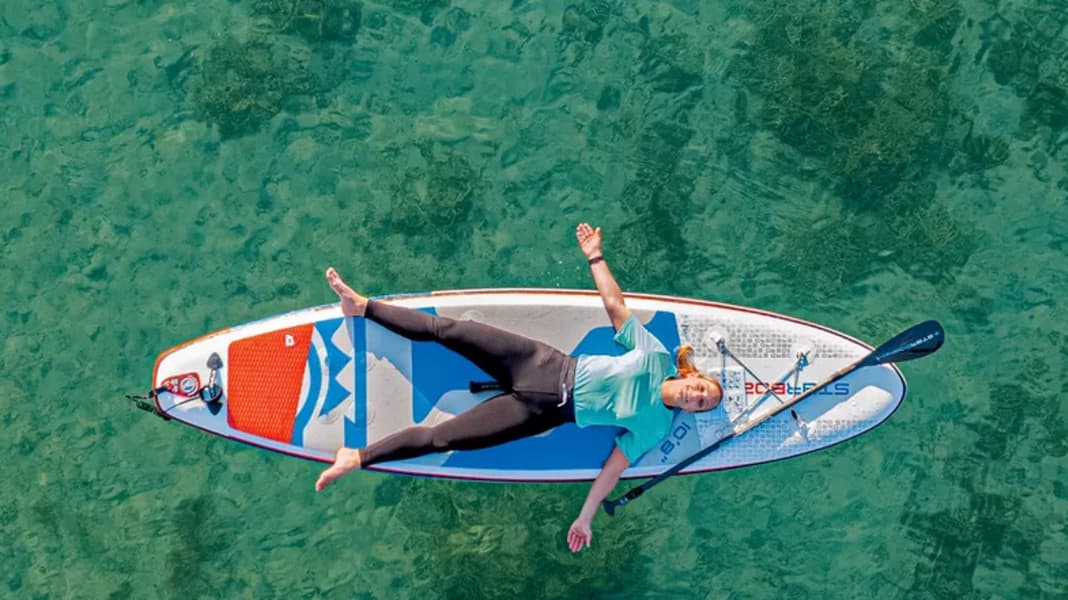
We present these exercises:
- Anjaneyasana: deep lunge, low lunge
- Viparita Virabhadrasana: inverted/peaceful warrior
- Prasarita Padottanasana: straddled standing forward bend
- Parivrtta Trikonasana: twisted triangle
- Malasana: Yoga squat, garland pose
- Kakasana / Bakasana: Crow / Crane
- Paripurna Navasana: the perfect boat
- Vasisthasana: Side support
- Purvottanasana: inverted plank pose
- (Parivrtta) Uttana Pristhasana: (Twisted) Lizard
- Shalabhasana: Grasshopper
- (Eka Pada) Setu Bandha Sarvangasana: (one-legged) shoulder bridge
This type of yoga is suitable for everyone. Even for men who don't usually go to yoga groups that often.
The best yoga exercises on the SUP
"I hope you're not made of sugar, because it's quite possible to fall into the water, especially when doing stances. The play instinct often kicks in on the board and it can happen that you overestimate yourself. Due to the unstable surface, all exercises are more difficult than on land. You need more balance and stability, but also benefit from more intensive training of the deep muscles. But don't worry, there are many variations, so listen to your body and only go as far as feels good for you today."
Anjaneyasana: deep lunge, low lunge
Start in downward facing dog, pull one leg forwards between your hands and lower the knee of the back leg towards the board. Make sure that the lower leg of the front leg is placed perpendicular to the board so that the knee is above the ankle. First support yourself on your thigh with outstretched arms to straighten up, then stretch your arms towards the sky and come into a slight backbend. To protect your back, make sure that the backbend comes subtly from the thoracic spine and not from the lower back. For more of a challenge, tuck your toes and lift your back leg off the floor.
- EffectStretching the front of the thighs, groin and hip opening.
- Level of difficulty: light
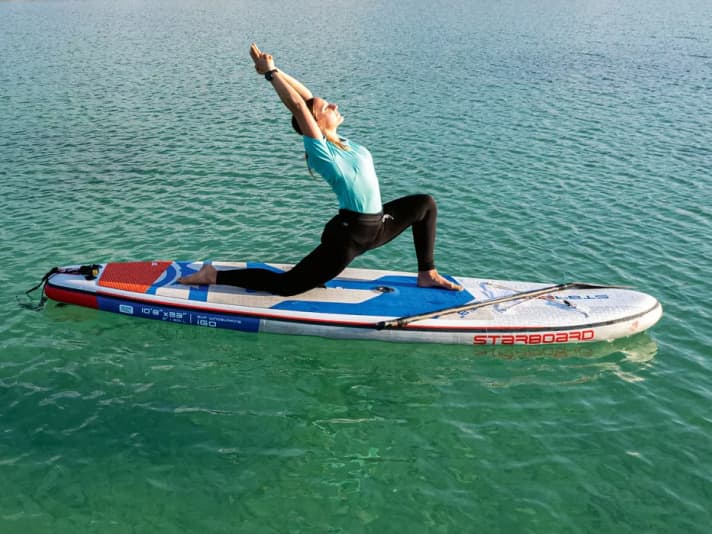
Viparita Virabhadrasana: inverted/peaceful warrior
Start in a standing position and do a big lunge. Turn your back foot out and bend your front leg until your thigh is at a 90° angle to your lower leg. Make sure that your knee is over your ankle and your hip is turned up parallel to the long side of the board. Extend your arms sideways to shoulder height, then come into a slight backbend and lower your back arm until your hand is on your thigh and extend the other arm upwards. The further you go into the backbend, the more intense the stretch becomes.
- EffectStrengthening the legs, stretching the flanks, opening the hips and mobilising the spine.
- Level of difficulty: medium/heavy

Prasarita Padottanasana: straddle standing forward bend
Start in a standing position, take a big lunge, turn all the way to the side,
parallel to the long side of the board and rotate your feet slightly inwards. Bend your upper body forwards with a straight back. Your sternum should be pointing forwards and your tailbone should be pointing upwards. Start with a half forward bend, keeping your arms straight and placing your hands in front of you on the board. If you want more, lower your upper body until the crown of your head is almost on the board and bring your hands further back until they are in line with your feet, or place them next to your feet, or clasp your hands behind your back and bring your arms towards the floor.
- EffectStrengthening the legs, stretching the back of the legs.
- Level of difficulty: medium
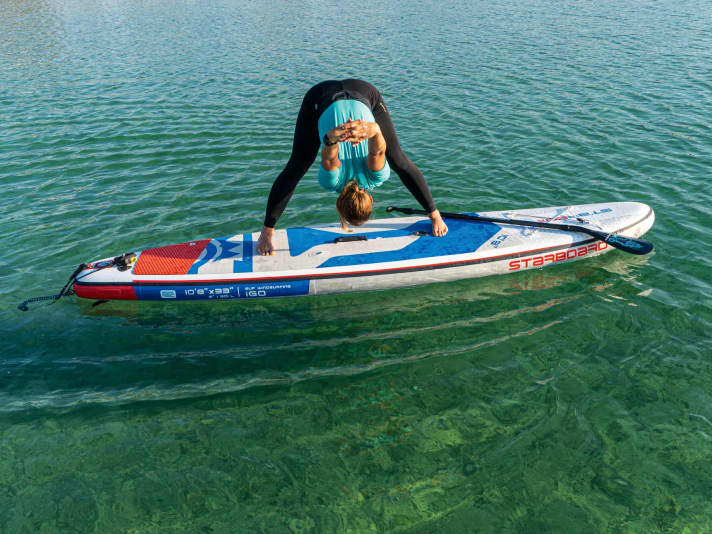
Parivrtta Trikonasana: twisted triangle
Start in a standing position and do a big lunge. Keep your hips facing forwards and your legs straight. Then bend your upper body forwards with a straight back until it is parallel to the board, place the opposite hand to the front leg on the board (alternatively on your shin), turn your chest up, place the other hand on your tailbone or stretch your arm towards the sky. Tip: The greater the distance between your foot and hand on the board, the easier it is to keep your balance. On land, you would even try to bring your hand to the outside of your front foot.
- EffectStrengthening and stretching the legs, mobilising the hips and spine.
- Level of difficulty: medium/heavy
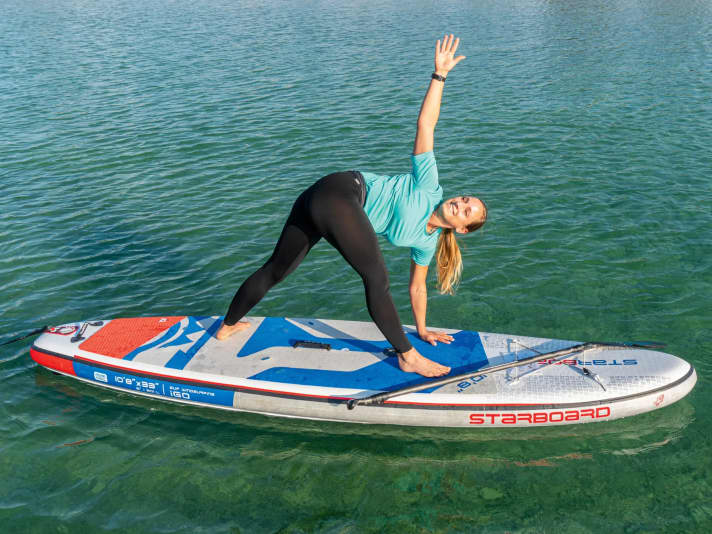
Malasana: Yoga squat, garland pose
Start in a standing position and bring your feet to the edge of your board. Now come into a deep squat and make sure your back is straight. Place your hands in prayer position in front of your heart and place your elbows on the inside of your thighs. If you can't get that deep without lifting your heels, then stay a little higher with your buttocks, but continue to keep your back straight. If you want even more stretch, you can go into a twist by gripping the edge of your board with one hand and stretching the other arm towards the sky.
- Effect: Stretching of the groin and back, mobilisation of the ankles and hip opening.
- Level of difficulty: light

Kakasana / Bakasana: Crow / Crane
Start in Malasana and place your hands on the board in front of you with your fingers spread apart. For crow, keep your arms bent at first and slowly add weight to your arms. Bring your knees to your armpits and alternately lift one foot at a time off the board. When you feel confident, slowly take both feet off the board and try to keep your balance and bring your big toes together. If this works well, you can try the crane. To do this, place your knees in your armpits and keep your arms straight.
- Effect: Strengthening the arms and wrists, as well as the abdominal muscles.
- Level of difficulty: difficult
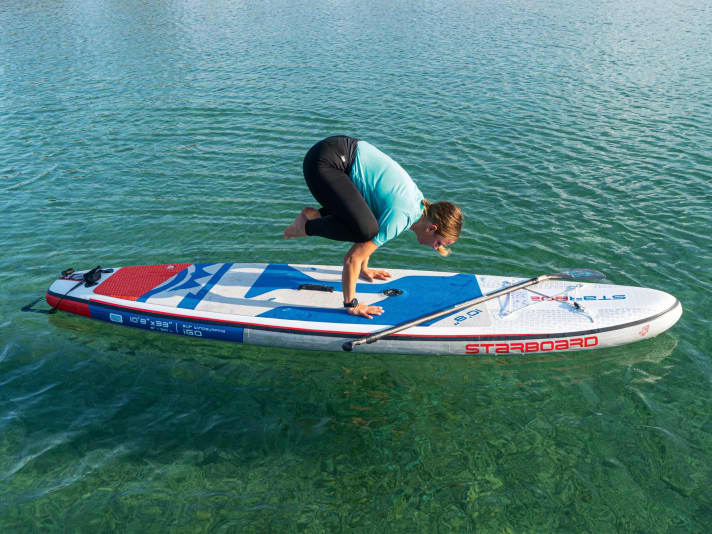
Paripurna Navasana: the perfect boat
Start in an upright position with your legs outstretched and stretch your arms forwards shoulder-high so that your palms are facing upwards. Lean back slowly with your back straight, lift your sternum and then lift your legs off the floor at the same time until you are balanced on your sitting bones. To start, you can bend your legs at a right angle or support yourself with your forearms. If you want more of a challenge, you can get into the full boat by stretching out both legs. Regardless of the variation, lower your legs and upper body towards the board at the same time and slowly come back up just before you touch the board. Repeat this exercise several times.
- Effect: Strengthening the abdominal muscles, hip flexors and back.
- Level of difficulty: simple
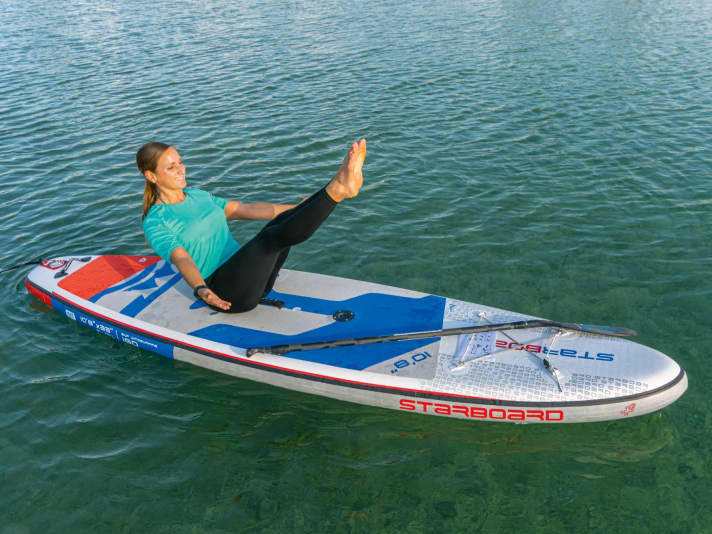
Vasisthasana: Side support
Start in a forearm support, bring one arm to the centre of the board, shift your weight and turn up to the side. Stretch your upper arm towards the sky. If it's too wobbly, you can put one knee on the board. And if you want a bit more of a challenge, you can move from the forearm support to the hand. For a more intense core workout, you can stretch your top leg in the air. Or for more stretching, you can stretch your upper arm over your head towards the board.
- Effect: Strengthening the lateral abdominal muscles, arms, wrists and legs. Stretching the upper side of the body.
- Level of difficulty: medium
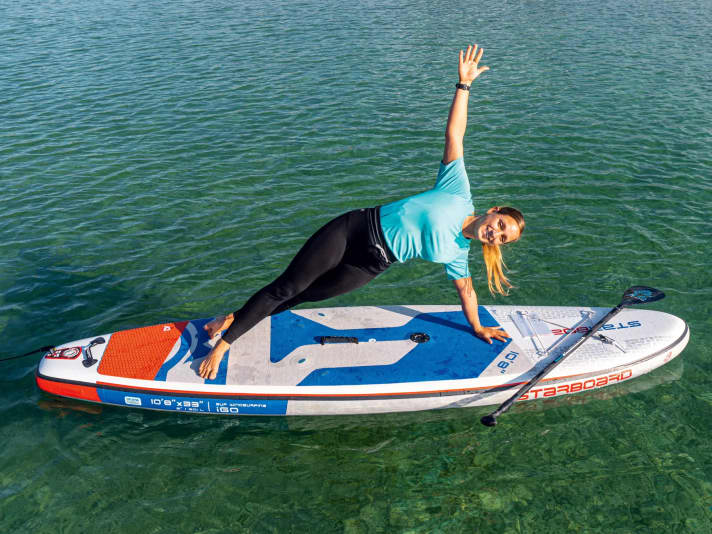
Purvottanasana: inverted plank pose
Start in a seated position and place your hands behind your hips on the board. Put your feet up and push your hips up so that you are in the upside-down table pose. Either stay here or keep going and extend your legs without your hips losing height. Press the soles of your feet into the board. Make sure that your gluteal muscles remain relaxed. For an extra challenge, you can lift one leg, but only if the rest of your body remains stable and your hips don't drop.
- Effect: Strengthening the arms, shoulders, wrists and ankles as well as the core and leg muscles.
- Level of difficulty: medium
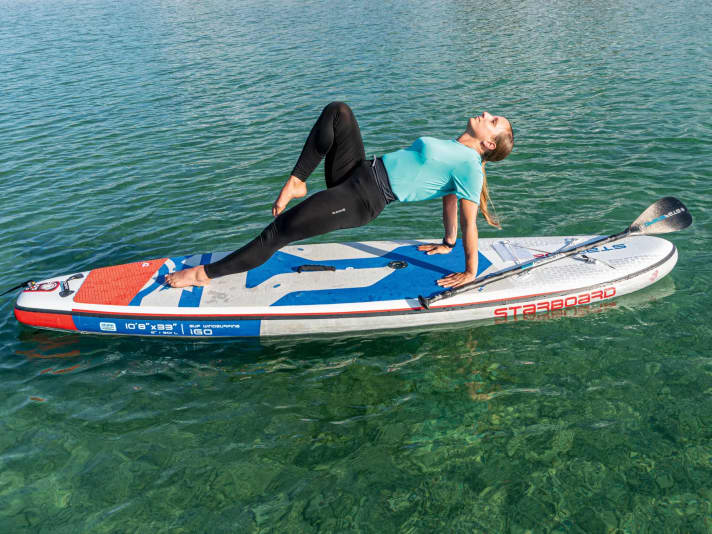
(Parivrtta) Uttana Pristhasana: (Twisted) Lizard
Start in Downward-Facing Dog and bring one foot forward to the outside of your arm. The back leg remains straight in the air with your toes pointed up. For a more intense stretch, you can come onto your forearms or perhaps even try to come under your knee with your shoulder. You can also go into a twist by placing your back leg and instep on the board, rotating your upper body in and pushing your front leg further outwards with your arm extended. Optionally, you can then grab your back foot and pull it towards your buttocks for a more intensive stretch of the quadriceps.
- Effect: Stretching the front of the thigh, the hip flexor and the groin.
- Level of difficulty: medium
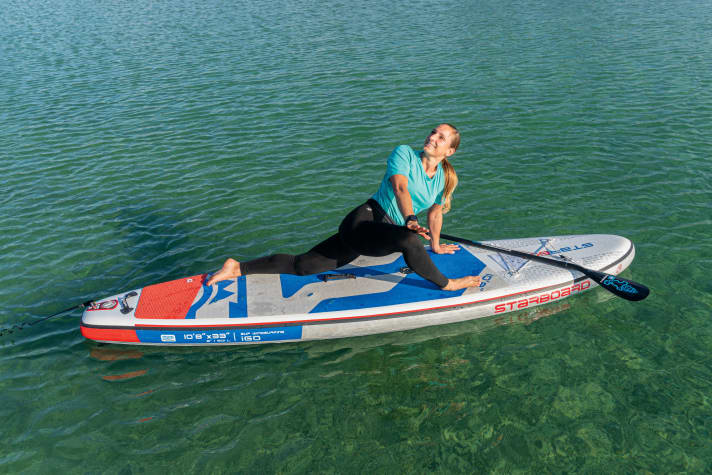
Shalabhasana: Grasshopper
Start in a prone position and stretch your legs out. Make sure that your legs are touching and that your buttocks remain relaxed. Firstly, stretch your arms out in front of you and raise only your arms and upper body. Then lower your upper body again, put your head down and wiggle your hips a little to take the pressure off your lower back. Next time, place your arms next to your body with your palms facing down and lift only your straight legs into the air. Try to get your big toes touching. Then pause again and raise your upper body and legs at the same time. Your arms can either be stretched forwards or backwards (e.g. with your hands clasped). For another variation, you can lift just one leg and support the outstretched leg with the foot of the other leg. The arms remain on the board.
- Effect: Strengthening the back muscles as well as the arms and back of the legs. Stretches the shoulders and chest.
- Level of difficulty: simple
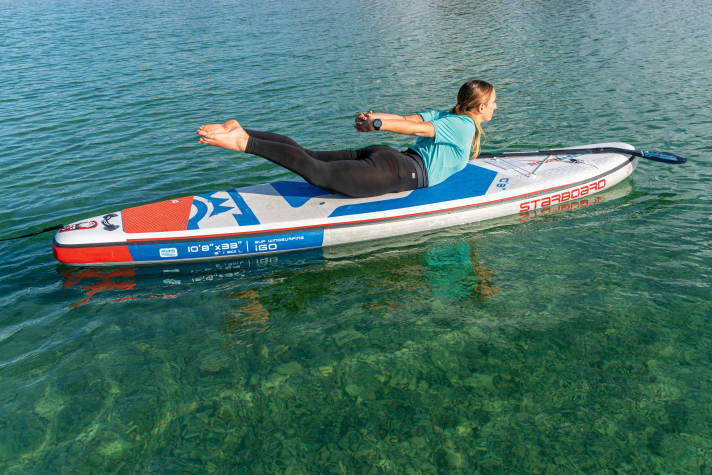
(Eka Pada) Setu Bandha Sarvangasana: (one-legged) shoulder bridge
Start lying on your back and place your feet hip-width apart so that you can touch your heels with your fingertips. Lift your pelvis upwards and keep your arms on the board. Optionally, you can clasp your hands under your buttocks to bring your shoulders even closer to your spine. Make sure that your glutes remain relaxed, your neck stays long and your knees don't tilt outwards. For more of a challenge, you can stretch one leg at a time towards the sky without lowering your hips. Then slowly roll your back vertebra by vertebra towards the board, stretch your legs out and feel for yourself.
- Effect: Strengthening the legs and lower back, stretching the hip flexors, abdominal and chest muscles.
- Level of difficulty: simple
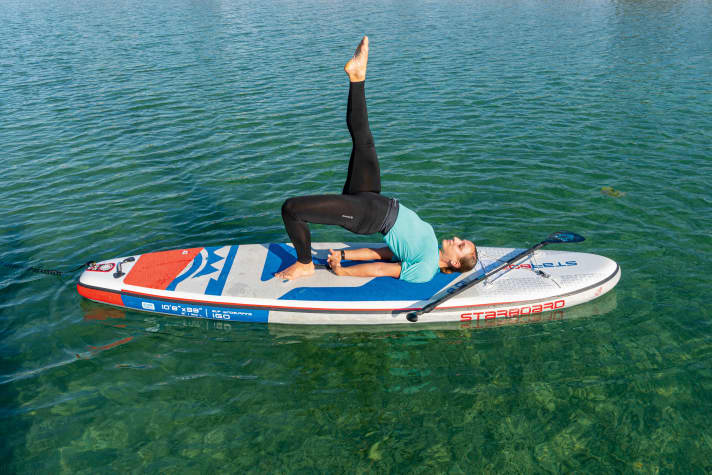
Interview with Kristina Andrä
How did you get into SUP yoga?
I have been an enthusiastic stand up paddler for years and have been teaching SUP since 2014, first in Brazil, then in Ireland, and later on Lake Starnberg and Lake Chiemsee. In January 2020, I completed a 200-hour yoga teacher training course in South India. And since I love water, SUP yoga was just the perfect combination for me - yoga on the board in the water.
Have you seen SUP yoga anywhere?
It just made sense to me. Yoga studios are often quite full and it always bothered me when I stretched out my hand during exercises and then touched my neighbour because there was no room. So it made sense to simply paddle out on the board and do yoga on my own in the tranquillity of nature. Also because I can switch off really well and leave all the stress of everyday life behind me.
Do you have a favourite location for SUP yoga?
There are so many beautiful lakes. If I go alone, I naturally make sure that I go somewhere where there is no one. I paddle out a bit and if I'm on my own, I don't have to anchor, so it doesn't matter if I drift 200 metres further. With my courses, I tend to stay close to the shore in deep water and then we anchor. Of course, I also look for a quiet spot where the ferry doesn't go back and forth all the time or bathers stare at us while we do our exercises.
exercises.
How well do you have to be able to paddle for SUP yoga?
Not really at all. You just have to be able to keep your head above water. There are participants who have never been on a board before, but also some who are super experienced in paddling but have never done yoga in their lives. Some paddle out on their knees first, but usually everyone gets up to stand up.
So yoga skills are not required?
No, there are so many variations in yoga, everyone only goes as far as they can.
What external conditions need to be considered?
We always anchor as a group. As a rule, we have an old lifebuoy to which we all attach ourselves at the front and I, as a trainer, also attach myself to a normal boat anchor. Of course, you always have to adapt your clothing to the water temperature. Depending on how well you can keep your balance, you can sometimes fall into the water. But that's also the fun of it. Some people even jump in on purpose when it gets too hot in summer.
What is fundamentally different about SUP yoga on the board?
The balance. You train your deep muscles even more intensively. Everything that is still quite easy on land suddenly becomes a balancing act. A standard pose like the warrior 1 becomes quite wobbly and difficult on the board. This is not a problem on land. This is the case with almost all standing poses.
Can you say what kind of poses are best to start with?
Of course, the easiest thing to do is anything where you have at least three points of support on the board. If you are only standing on both legs, it is more difficult than if you still have your hands on the board and are doing the downward facing dog, for example. The easiest poses are of course the lying and sitting poses. And then it becomes very, very difficult on one leg. Pretty much anyone can do the "tree" on land. But on a board it's almost impossible, you need a lot of experience. Anything that only has one support surface is extremely difficult.
This is also a normal SUP training exercise - paddling on one leg.
Yes, I do that very often. On the way out, some of the groups paddle out on their knees or are very wobbly. And once we've done our exercise, I sometimes motivate the participants to try paddling on one leg on the way back.
to try paddling on one leg. Some of them even manage it. Because yoga also gives you a good feel for the board.
Should you try it out in private first or can you dare to do it in a group? Won't that embarrass you?
Everyone has to decide that for themselves. But with yoga, the most important thing is not to compare yourself with others, but to really only do what you are personally able to do on the day. I can't do a tree on the board or a headstand every day. That also depends on your form on the day.
What do I need to look out for on the board? Can you do this on any inflatable SUP?
Of course, it depends on the person, but it's easier with a slightly wider all-rounder. It doesn't have to be a race board.
So the board on which you normally paddle can also be used?
Yes, actually everything except the racers. I'm also fine with my 28er board, but I wouldn't necessarily recommend it to beginners for yoga.
What else distinguishes yoga on the board from yoga in a traditional class?
This type of yoga is suitable for everyone. It may also be more interesting for men who don't usually go to yoga studios. The fun and play factor is also included on the board. It's also wobbly at times and the deep muscles are trained even more. Yoga on the board can also be really strenuous. But even yogis who already have a lot of experience experience a completely different challenge and find it nice to do yoga in a different environment, on the water, in nature. I think SUP yoga can also be interesting for those who wouldn't necessarily go to a studio to do yoga.
INFO on Instagram and directly on the Website of Kristina Andrä

